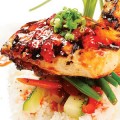Caribbean food conjures images of gentle breezes, daiquiris, Red Stripe beer and jerk chicken. But that picture is incomplete without oxtails.
Although they’re misunderstood by many, oxtails are the unsung pride of Caribbean cooking. Mention ox and a picture of a large, tough manly meat or a Flintstone-style cave man roasting a massive cut over a primitive fire arises. Oxtail conjures up images both bony and fatty that would seem to make it one of the least attractive cuts, like a pig’s foot. In a world of overexposed regional ingredients, the oxtail is still a relative unknown.
Oxtail is a Sunday food. The dish takes care and hours to prepare, the kind of care reserved for family and friends that kindles immediate nostalgia among natives missing their island roots. Oxtail is an expensive ingredient, an ox (or more likely, beef cattle), has only one tail. Reducing the tail to perfect morsels requires skill similar to a barbecue chef. The preparation is a point of pride among professionals.
Each tail must be dressed carefully, peeling back the skin and removing chunks of fat without removing the oval tidbits of meat from the X-shaped vertebrae. The entire tail is split into segments about 2 inches long at each joint to open the bone’s marrow, enriching the broth.
The chunks are then simmered at about 250 degrees for several hours, allowing the cartilage to soften and reduce and the fat to melt away. If simmered too long, the meat can toughen; too little, and fat remains. While simmering, savory ingredients like green onion and thyme are often added. Some chefs create more of a stew, adding tomatoes and garlic when nearly complete.
Oxtail is judged by the succulence of the meat. Each cooked tail segment has four little nubbins of meat nestled along the bone, which can be plucked off and eaten with fork and knife, or lifted between thumb and finger and nibbled almost like corn on the cob.
The meat should succulent and tender, like beef in beef Bourguignon. There should be no hint of gristle, fat, or toughness. The mouth-feel should be luxurious and slightly silky, and certainly not greasy. It’s a rich and earthy meat with taste that approaches foie gras, but with a texture similar to fillet mignon. Any sauce should serve to enliven rather than obscure the flavor of the meat.
Silicon Valley has a broad selection of excellent Cuban and Caribbean restaurants, a rare regional cluster that demands attention. Palo Alto boasts three: Coconuts and Mango Caribbean in the University Avenue area and La Bodeguita Del Medio on California Avenue. Menlo Park’s Back-A-Yard is renowned for oxtail and occupies a simple storefront that can charitably be described as a hole-in-the-wall. San Jose claims both Los Cubanos and Habana Cuba. With the exception of La Bodeguita Del Medio, each serves oxtail with pride.
Chef Robert Simmons owns Back-A-Yard and Coconuts. Back-A-Yard (the name is Jamaican slang for “back home”) is one of the Bay Area’s gems, with only 12 tables, counter service, unabashed down-home atmosphere, low prices and a varied clientele. Lunch is packed with workers from the Willow Road office parks and dinner draws locals from scruffy East Palo Alto as well as far-flung diners cruising in from the adjacent 101 off-ramp.
Oxtails ($12.95) are served on a bed of rice with a side salad and plantains, and the preparation shows the highest level of skill and care, with the meaty succulence in every bite. The dirty rice is exceptional, but the remaining sides are an afterthought on the disposable plates. Simmons describes his broth as “all about the green onion,” a perfect example of a brightening accent.
Habana Cuba s an oasis in an area that has seen better times. This slightly more upscale restaurant serves oxtail in tomato and red wine ($17), the spiciest dish on the menu. Chef Jennifer Echeverri delights in introducing customers to oxtail as a lunch special on Fridays. She gets four or five to try it each time. Her preparation differs greatly from Simmons’ in that the sauce is sprightly, anchored by tomato and seasoned slightly with Louisiana hot sauce, but the sauce is still light, allowing the meat to shine through.
Whether it’s from Coconuts, Back-A-Yard or Habana Cuba, oxtail offers a real taste of the islands.

 Best Bites: Vietnamese Food
Best Bites: Vietnamese Food  Live Feed: Fall Flavors
Live Feed: Fall Flavors 


